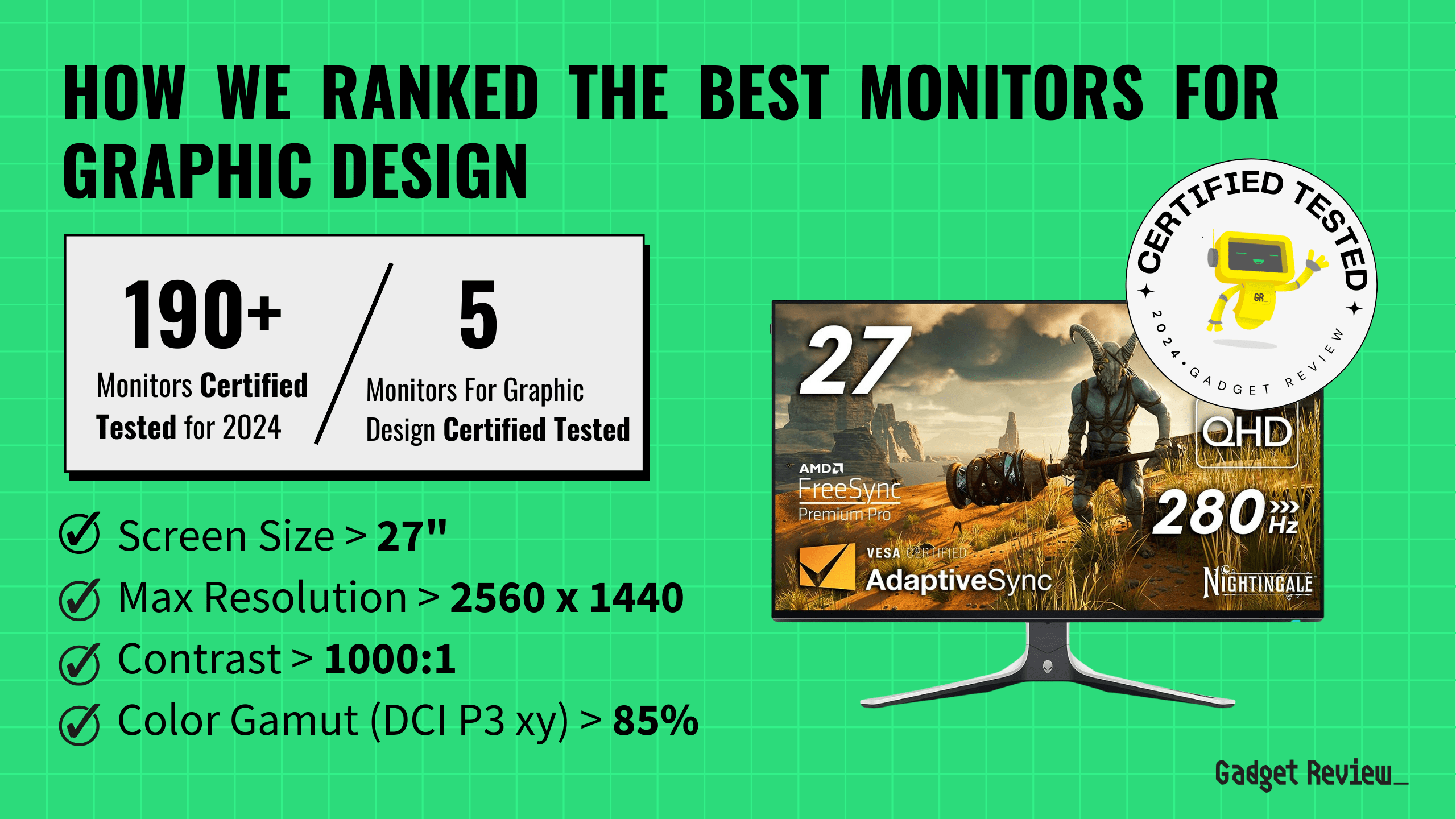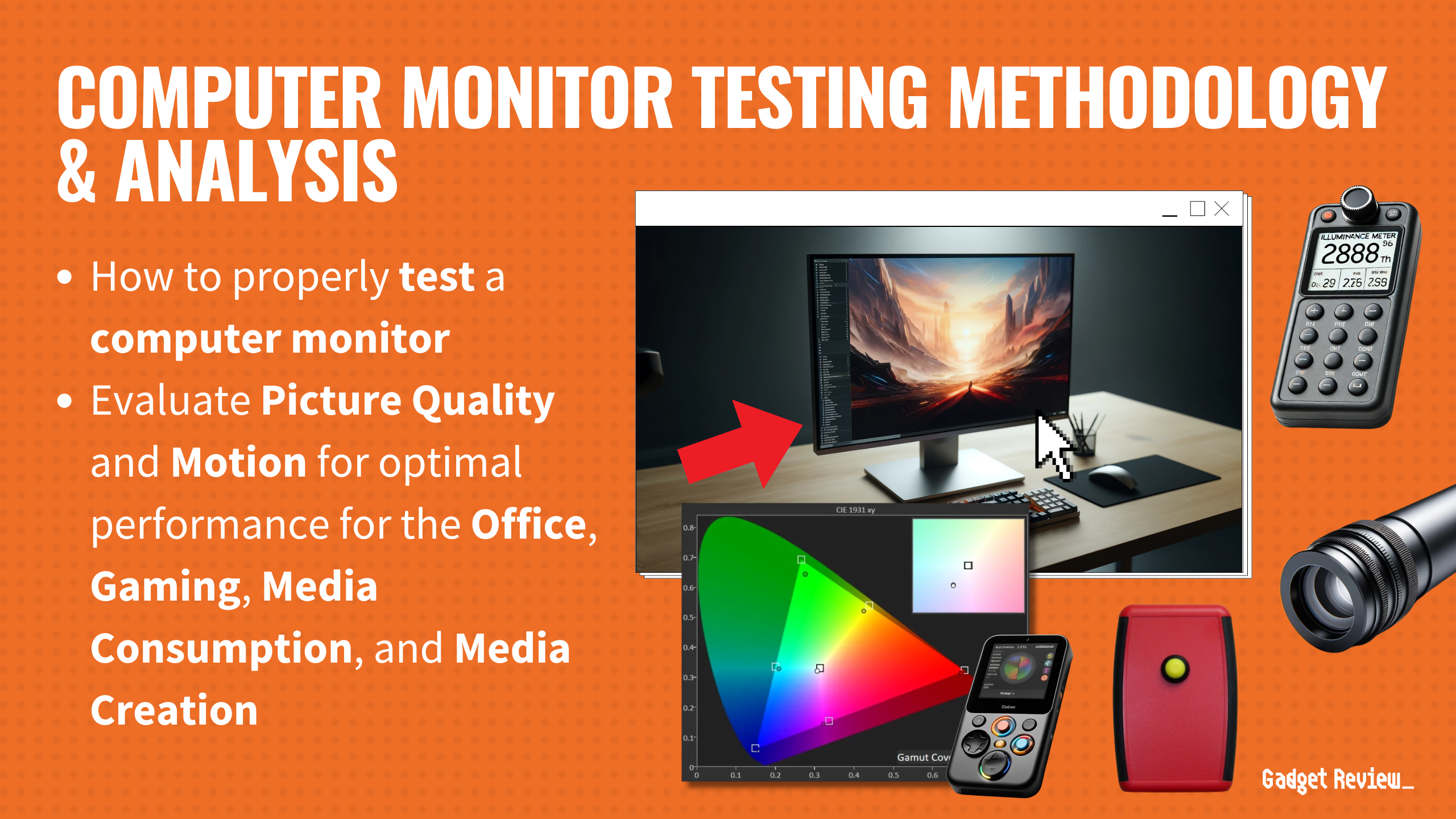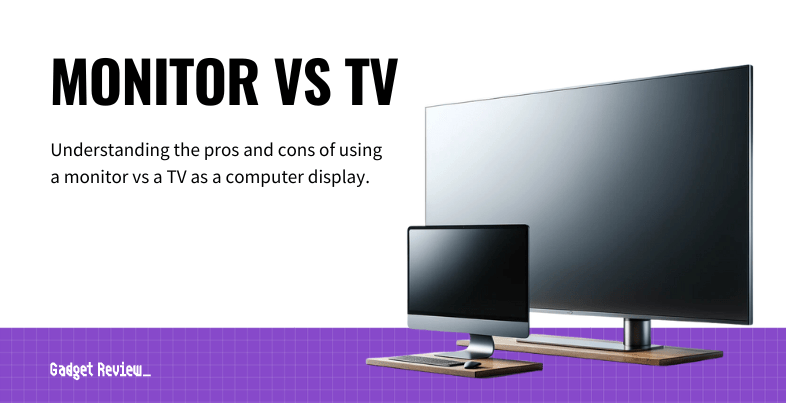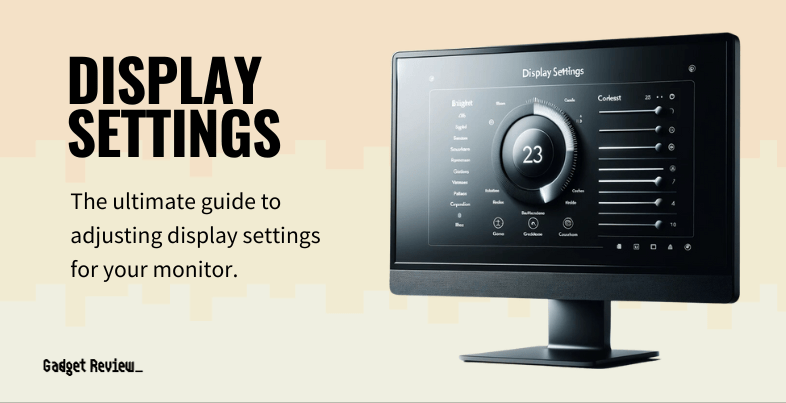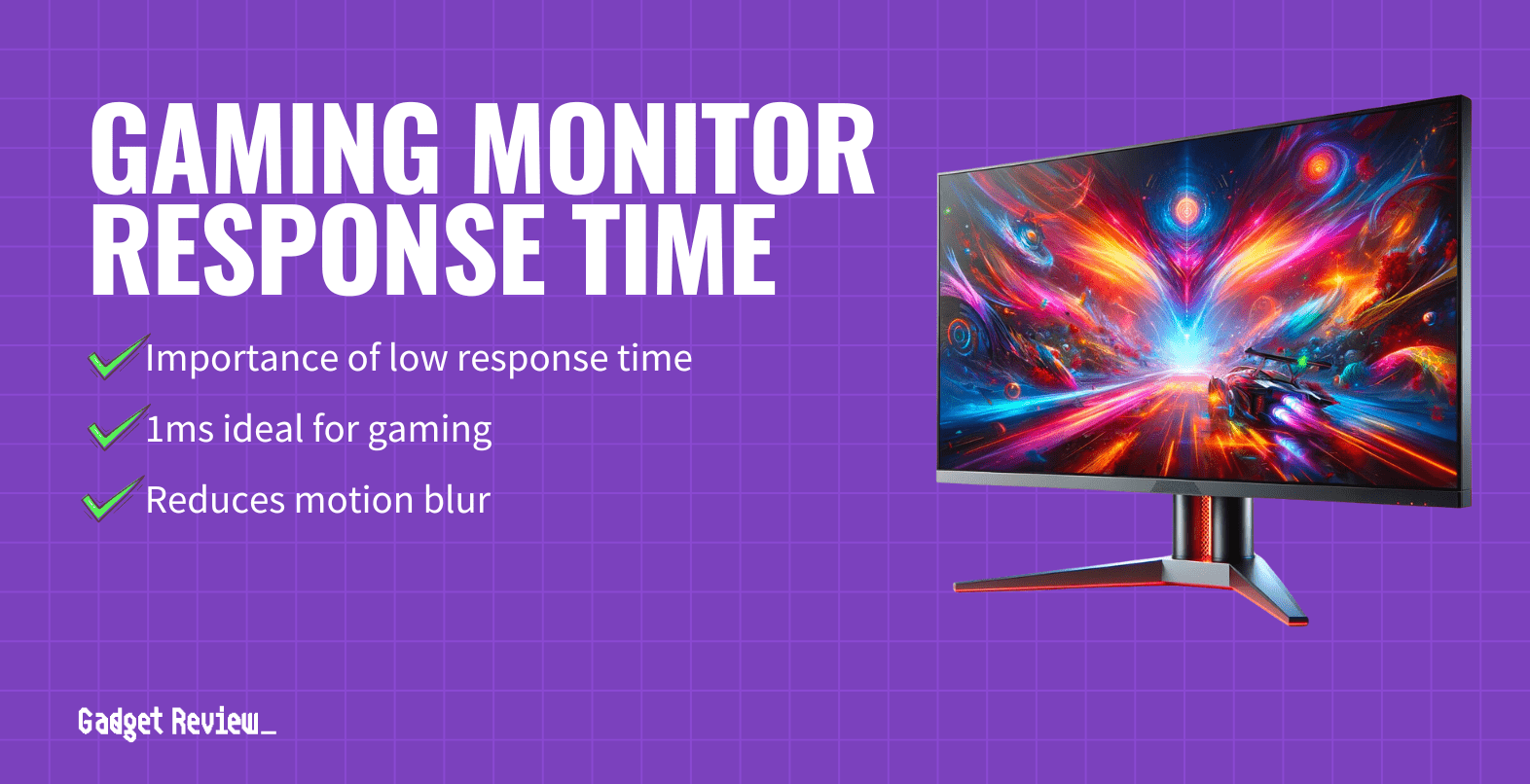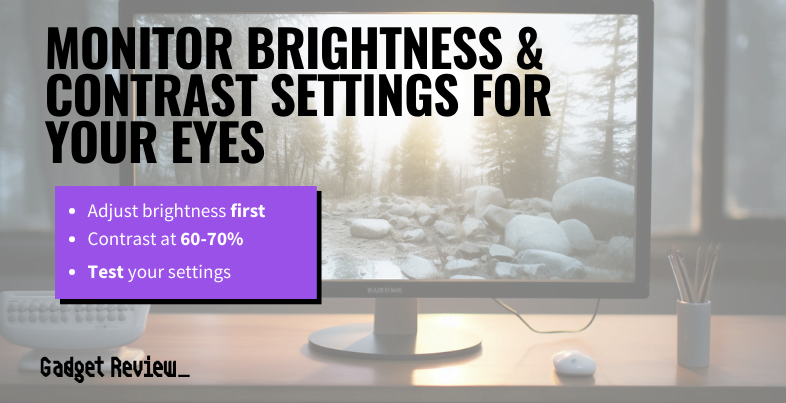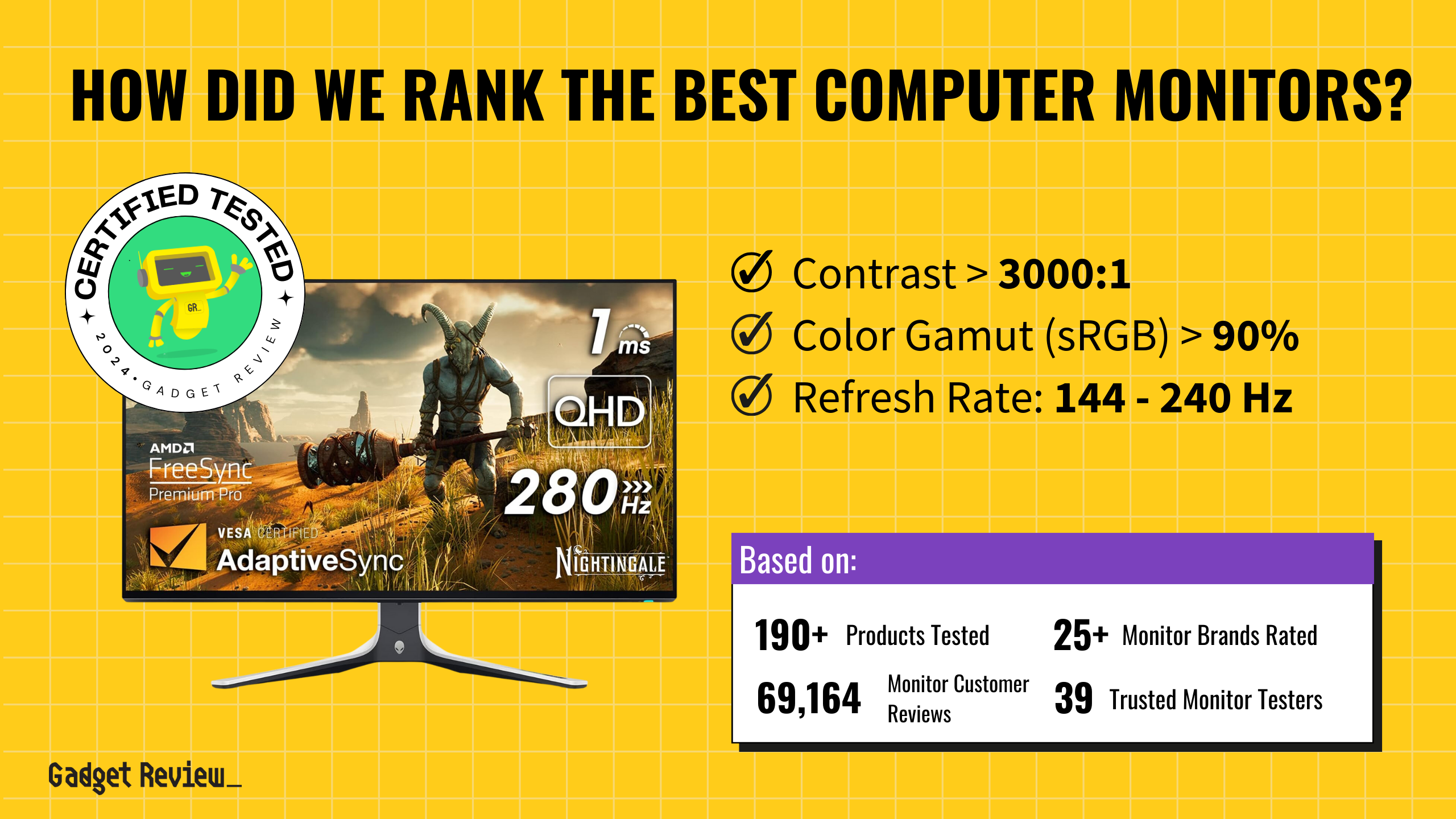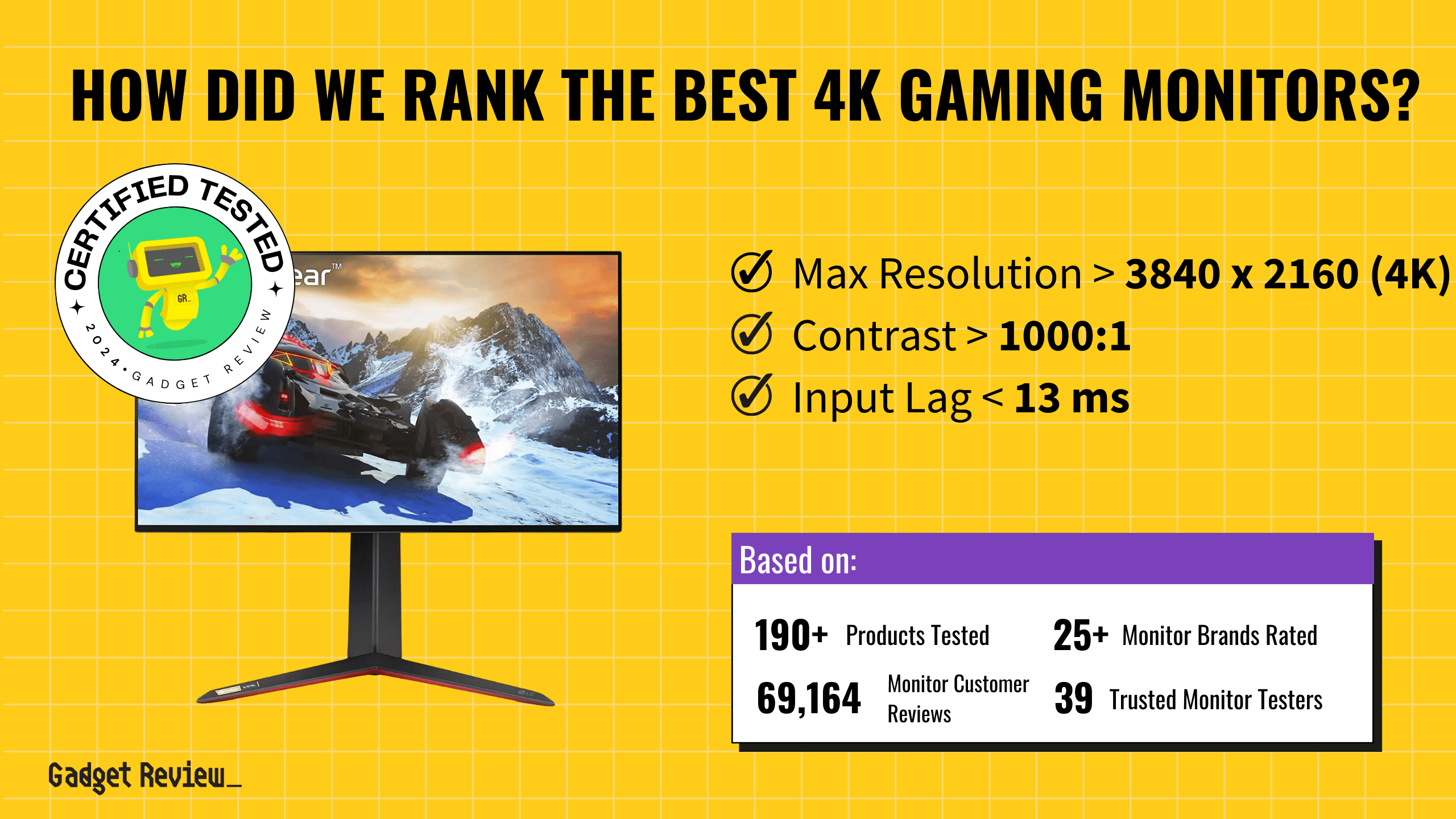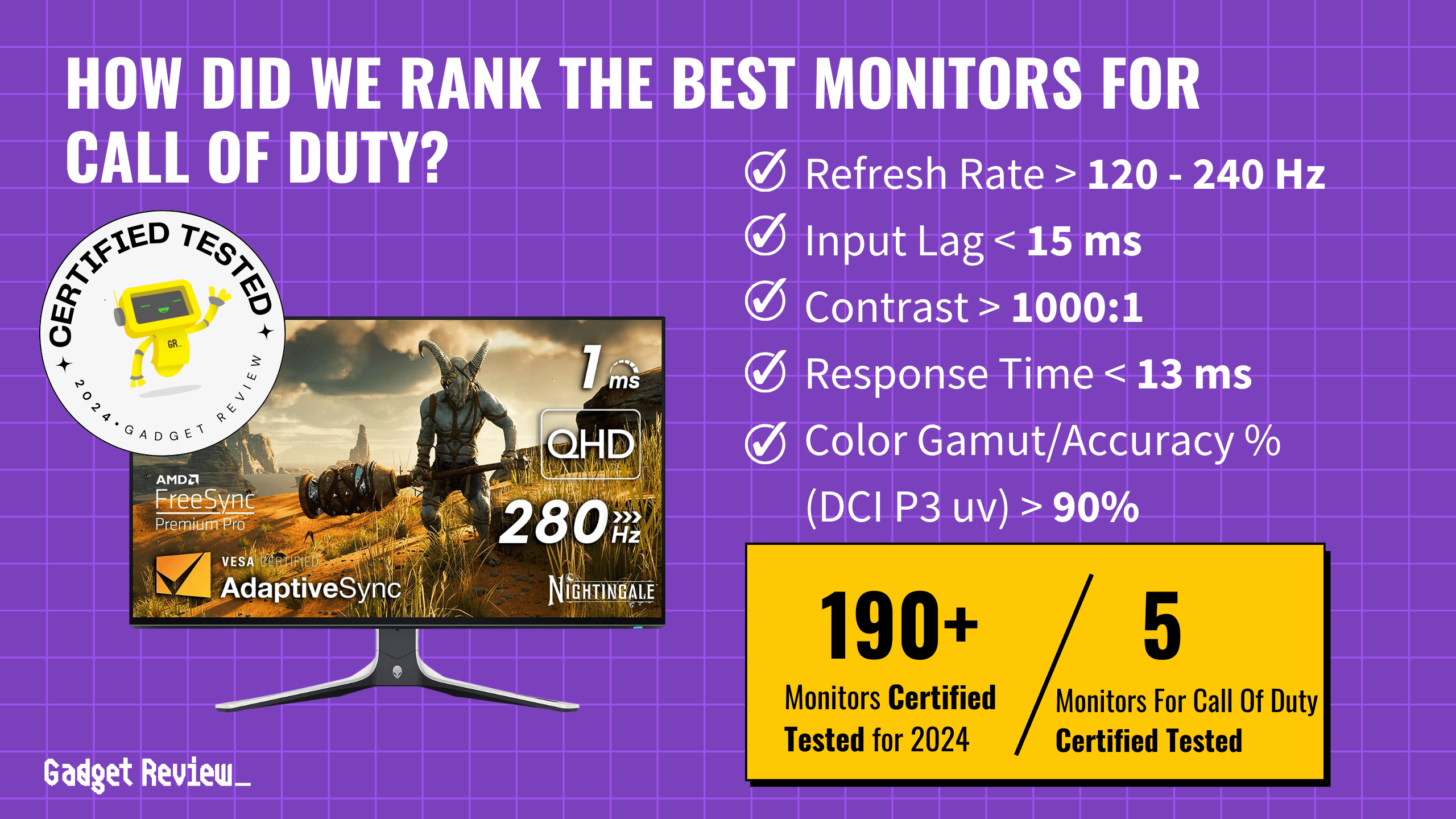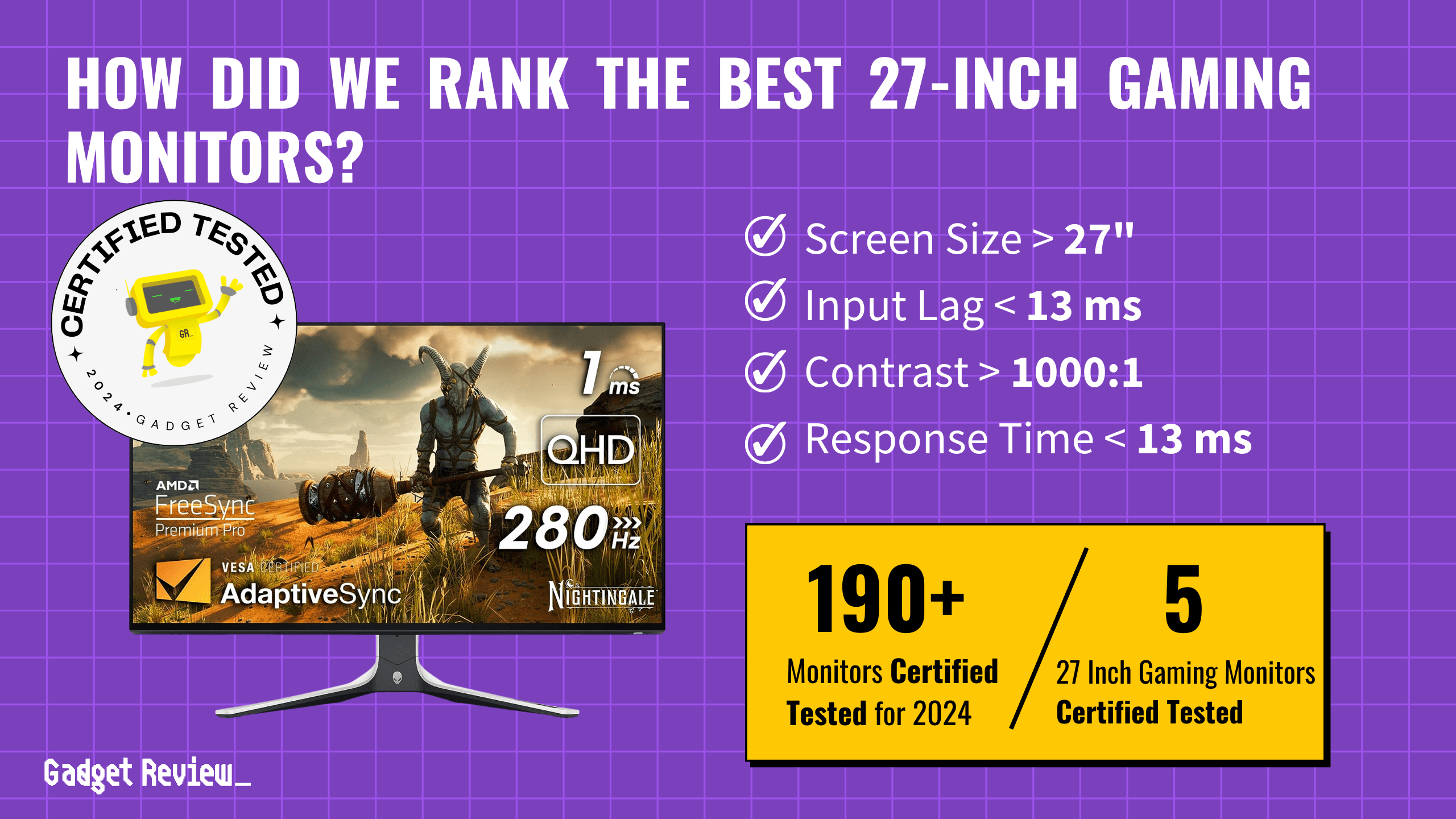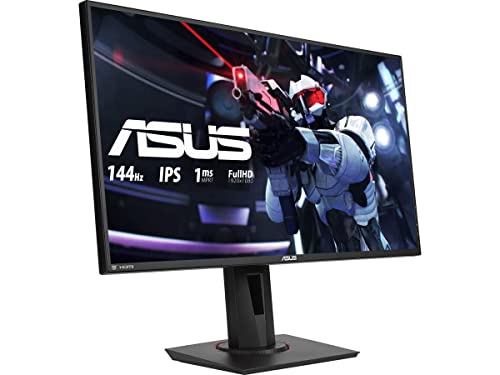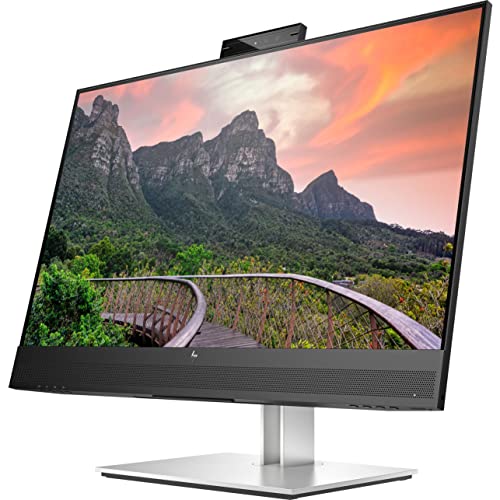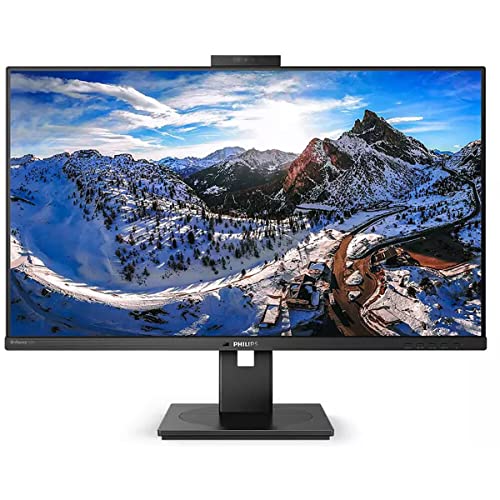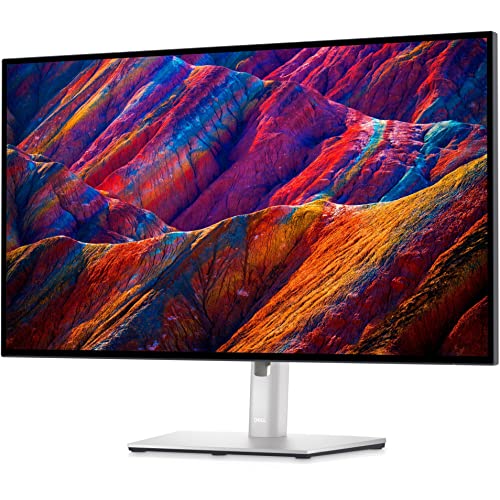When you’re working in graphic design, a monitor with exceptional color accuracy, high resolution, and excellent contrast is essential. The best monitors for graphic design offer wide color gamut coverage, such as 100% sRGB or AdobeRGB, and low Delta E values for precise color matching. They also need to have minimal reflection and adjustable ergonomics to reduce eye strain during long design sessions. These features ensure your work is displayed accurately, making color-critical tasks easier and more efficient.
We analyzed 196 monitors and identified five that excel in these areas. Our unique approach involved certifying products as tested, filtering out fake and low quality reviews using our proprietary Trust Score, and analyzing 319,918 reviews. Shockingly, 71% of experts weren’t trustworthy. The five winning monitors performed exceptionally well, proving they are the best choices for graphic design professionals. In addition to being great for graphic design, the best computer monitors excel at other tasks, including video editing and gaming. Furthermore, we have a guide including options for the top monitors for watching movies, ensuring vibrant colors and crisp images for an immersive viewing experience.
How Did We Rank the Best Monitors for Graphic Design?
When determining the best monitors for graphic design, we meticulously analyzed over 200 sites to ensure our recommendations are the most accurate. Our approach included scrutinizing various testing methods, evaluating customer reviews, and synthesizing expert opinions. We identified the critical criteria that matter most: 2 required test results and 2 must-have specifications. This thorough process allows us to confidently guide you to the top monitors that will meet your graphic design needs.
Our commitment to unbiased reviews is powered by our ‘True Score’ system, targeting low quality and fake reviews. When you shop through our links, you’re backing our mission. Dive deeper to see how.
?️ Minimum Specifications
- Must have a 27″ screen
- Must have a max resolution of more than 2560×1440
? Test Criteria
- Contrast Ratio: 1000:1 or higher (infinite), offering deep blacks and bright whites for an exceptional viewing experience.
- Color Accuracy: At least 85% of the DCI P3 color gamut, providing rich and vibrant colors.
Latest Updates
- 05/02/2024: Republished the list to include the best monitors for graphic design based on our True Score system.
Top Monitors for Graphic Design For 2025
Prices accurate at the time of publishing

Best Overall

Runner Up

Best Value

Best Budget

Best Mid-Range

Premium Pick
HP OMEN 27QS
Best For Watching Movies
It offers exceptional color precision at a budget-friendly price, making it suitable for design and gaming. Adequate brightness, but the contrast could be better. Excellent value for designers.
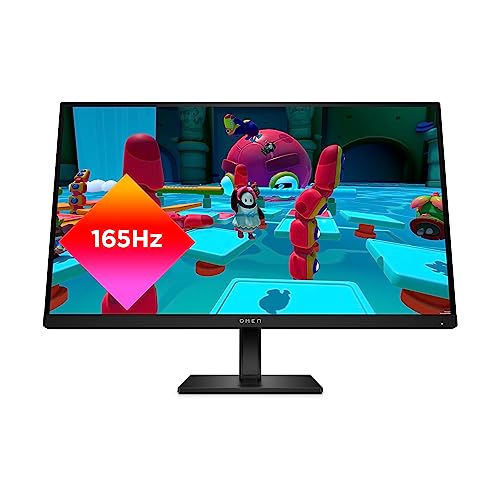
True Score
85834Experts
911kCustomers
Absolutely Fresh
 SAVE $100$299.99$199.99
SAVE $100$299.99$199.99Snapshot
Reasons to Buy
- Good Image quality
- Low response time
- Low input lag
- High refresh rate
Reasons to Avoid
- Low contrast ratio
Specifications

Aspect Ratio 16:9 
Available Inputs 3.5mm, DisplayPort, HDMI, USB 
Bluelight Filter Yes 
Built-In Speakers Yes 
Built-In Webcam No 
Curved Screen No Display Type LED 
Flicker Free Yes HDMI Inputs 2 HDR Format HDR10, HDR400 High Dynamic Range (HDR) Yes Max Resolution 2560 x 1440 
Panel Type IPS Refresh Rate 240 Hz 
Response Time 1 ms 
Rotating Screen Yes Screen size 27″ 
Sync Technology AMD FreeSync Premium, G-Sync All Specs
Test Results
Brightness (nits) 390 Contrast Ratio (as ratio, x:1) 1,014 Color Gamut/Accuracy % (DCI P3 xy) 94 Color Gamut/Accuracy % (DCI P3 uv) 0 Color Gamut % (Adobe RGB Coverage xy) 86 Color Gamut % (sRGB Coverage xy) 100 All Retailers
- $199.99$300Save $100
- $359.99$480Save $120
- $429.00
Our Verdict
If you’re looking for an affordable monitor for graphic design, the HP OMEN 27QS is a standout choice that doesn’t skimp on color precision. With a DCI P3 color gamut of 94.4% and 100% sRGB coverage, it’s ideal for a wide range of design tasks, from photo manipulation to video editing and creating HDR content. Its brightness of 389.5 nits ensures your designs will look vibrant and keep bright offices from being a nuisance.
Though it sports a more accessible price tag than the slightly pricier Dell G2724D, it does compromise somewhat on contrast (1014:1 compared to Dell’s 1350:1), which is the only notable shortcoming of the OMEN 27QS. However, this doesn’t detract significantly from its overall performance. For designers who enjoy gaming in their downtime, the monitor’s swift response time of 4.2 ms and input lag of 8.5 ms offer a seamless transition from work to play.
The OMEN 27QS also employs IPS technology for consistent and accurate color display across various angles. Added comforts such as a rotating screen, flicker-free viewing, and a blue light filter make it suitable for extended design sessions. While it includes built-in speakers, they’re more functional for casual listening than professional audio work.
The HP OMEN 27QS represents exceptional value, balancing cost with performance. Its reliable color fidelity, ample brightness, smooth responsiveness, and thoughtful design features make it a compelling option for graphic designers seeking quality and affordability in their creative toolkit and everyday productivity and gaming.

Best Overall

Runner Up

Best Value

Best Budget

Best Mid-Range

Premium Pick
Corsair Xeneon 27QHD240
Best For Mac Mini
Premium OLED monitor with unparalleled color accuracy and deep contrast. It is perfect for serious design work, though costly. Beware of burn-in risks with static images. Top choice for quality.
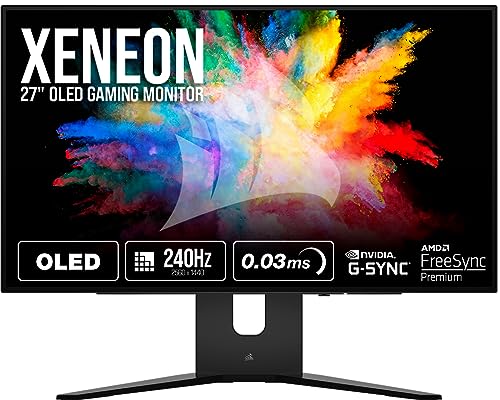
True Score
838310Experts
88336Customers
Absolutely Fresh
 SAVE $250$999.99$749.99
SAVE $250$999.99$749.99Snapshot
Reasons to Buy
- Excellent OLED Picture Quality
- Ultra-Fast Response Time
- Low Input Lag
- High Refresh Rate and VRR Support
Reasons to Avoid
- Lower Peak Brightness Levels
- Higher Input Lag with Different Refresh Rates
- Potential OLED Burn-In
Specifications

Available Inputs 3.5mm, DisplayPort, HDMI, USB 
Bluelight Filter Yes 
Built-In Speakers No 
Built-In Webcam No 
Curved Screen No Display Type OLED 
Flicker Free Yes HDMI Inputs 2 HDR Format HDR10 High Dynamic Range (HDR) Yes Max Resolution 2560 x 1440 
Panel Type OLED Refresh Rate 240 Hz 
Response Time 0.03 ms 
Rotating Screen Yes Screen size 27″ 
Sync Technology AMD FreeSync, G-Sync All Specs
Test Results
Brightness (nits) 318 Contrast Ratio (as ratio, x:1) 9,473 Color Gamut/Accuracy % (DCI P3 xy) 96 Color Gamut/Accuracy % (DCI P3 uv) 0 Color Gamut % (Adobe RGB Coverage xy) 90 Color Gamut % (sRGB Coverage xy) 107 All Retailers
- $749.99$1,000Save $250
- $999.99
- $1,103.65
Our Verdict
For graphic designers who prioritize precision and fluidity in their visual work, the Corsair Xeneon 27QHD240 stands out with its exceptional performance. With an unparalleled response time of 0.79 ms and a 13.6 ms input lag, it combines gaming-grade speed with the finesse needed for design tasks.
Its remarkable color accuracy, featuring 96.12% DCI P3 and 106.96% sRGB coverage, makes it a top choice for intricate design projects, video editing, and viewing HDR content. The OLED panel gives it a contrast ratio of 9473:1, providing unparalleled depth and nuance in imagery. Burn-in with OLED screens is still a problem, so be mindful of static images and elements on your screen over long periods.
While LED alternatives might overshadow its brightness of 317.53 nits, it’s good enough for most design environments unless you’re working under direct sunlight. Comfort-enhancing features such as a rotating screen, flicker-free output, and a blue light filter support prolonged creative sessions without straining the eyes.
The biggest drawback with the Xeneon 27QHD240 is its cost – OLED displays are still very expensive, but they deliver premium image quality and performance. If you need the highest fidelity and performance in your creative toolkit, it’s hard to go with anything else. Its superior color range, deep contrasts, and swift response times make it a worthwhile premium option that can handle editing as easily as it can gaming and multimedia applications.

Best Overall

Runner Up

Best Value

Best Budget

Best Mid-Range

Premium Pick
Dell G2724D
Best For Cheap
Best for working in bright conditions with outstanding brightness and color accuracy. A strong contrast ratio enhances detail. Affordable and versatile for graphic design and casual gaming.
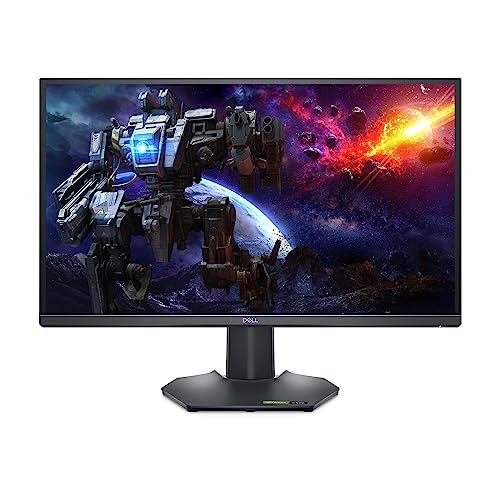
True Score
82822Experts
88126Customers
Absolutely Fresh
 SAVE $47$299.99$253.00
SAVE $47$299.99$253.00Snapshot
Reasons to Buy
- Great image quality
- Low Input lag
- High native refresh rate
Reasons to Avoid
- Subpar contrast ratio and HDR color gamut
- Okay response time
- No HDMI 2.1 and USB ports
Specifications

Aspect Ratio 16:9 
Available Inputs DisplayPort, HDMI 
Bluelight Filter Yes 
Built-In Speakers No 
Built-In Webcam No 
Curved Screen No Display Type LED 
Flicker Free Yes HDMI Inputs 2 HDR Format HDR10, HDR400 High Dynamic Range (HDR) Yes Max Resolution 2560 x 1440 
Panel Type IPS Refresh Rate 165 Hz 
Response Time 1 ms 
Rotating Screen Yes Screen size 27″ 
Sync Technology AMD FreeSync Premium, G-Sync, VESA Adaptive-Sync All Specs
Test Results
Brightness (nits) 432 Contrast Ratio (as ratio, x:1) 1,350 Color Gamut/Accuracy % (DCI P3 xy) 86 Color Gamut/Accuracy % (DCI P3 uv) 0 Color Gamut % (Adobe RGB Coverage xy) 82 Color Gamut % (sRGB Coverage xy) 100 All Retailers
- $253.00$300Save $47
Our Verdict
If you’re stuck doing your design work in brightly lit environments, the Dell G2724D features a fantastic brightness of 432.0 nits. This ensures your designs remain visible under intense ambient light, though be mindful of potential glare due to its 4.8% reflectivity.
While its DCI P3 coverage at 86.35% may not be optimal for video editing tasks, its 100% sRGB spectrum is perfectly suited for digital illustration, graphic design, and web development, ensuring accurate color representation across various projects.
Offering a robust contrast ratio of 1350:1, the G2724D surpasses even pricier competitors like the Alienware AW2723DF in delivering rich depth and detail. It is an excellent tool for creating and reviewing design work. Its quick response time of 4.3 ms and reasonable input lag of 9.0 ms also provides an added advantage for designers who game in their downtime.
Equipped with IPS technology, it affords wide viewing angles, essential for collaborative reviews and multi-monitor setups. Moreover, design-centric features like a rotating screen, flicker-free technology, and a blue light filter cater to extended work sessions, ensuring comfort and reducing eye fatigue.
With one of the lowest prices on our list, the Dell G2724D is an exceptional bargain for creative professionals. Its combination of high brightness, precise color accuracy, and thoughtful design features make it a versatile pick for graphic design, web browsing, and even gaming, all without stretching your budget.

Best Overall

Runner Up

Best Value

Best Budget

Best Mid-Range

Premium Pick
Alienware AW2723DF
Best For 27-Inch
It is ideal for gaming and graphic design, with superior color accuracy and high brightness. However, due to glare, it is not the best in very bright environments. It is a premium choice for demanding users.
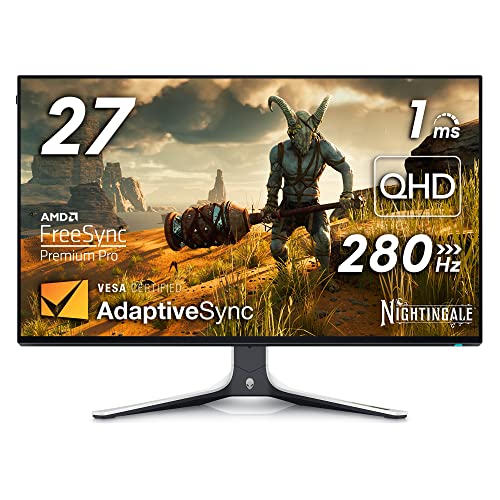
True Score
78804Experts
81293Customers
Mixed Reviews
 SAVE $200$649.99$449.99
SAVE $200$649.99$449.99Snapshot
Reasons to Buy
- Superb image quality
- Low input lag
- High native refresh rate
Reasons to Avoid
- Mediocre contrast ratio
- Adequate response time
- No HDMI 2.1
Specifications

Available Inputs 3.5mm, DisplayPort, HDMI, USB 
Bluelight Filter Yes 
Built-In Speakers No 
Built-In Webcam No 
Curved Screen No Display Type IPS 
Flicker Free Yes HDMI Inputs 2 HDR Format HDR10, HDR600 High Dynamic Range (HDR) Yes Max Resolution 2560 x 1440 
Panel Type IPS Refresh Rate 240 Hz 
Response Time 1 ms 
Rotating Screen Yes Screen size 27″ 
Sync Technology AMD FreeSync Premium Pro, G-Sync All Specs
Test Results
Brightness (nits) 403 Contrast Ratio (as ratio, x:1) 1,015 Color Gamut/Accuracy % (DCI P3 xy) 93 Color Gamut/Accuracy % (DCI P3 uv) 0 Color Gamut % (Adobe RGB Coverage xy) 90 Color Gamut % (sRGB Coverage xy) 100 All Retailers
- $449.99$650Save $200
- $598.99$705Save $106
Our Verdict
If you want a monitor capable of graphic design and gaming, the Alienware AW2723DF offers superior overall performance. Its high brightness level of 402.8 nits offers vivid imagery, but its 7.2% light reflectivity, which can create issues with glare, makes it not ideal for very bright offices.
Color fidelity is paramount for graphic design, and the AW2723DF excels with a 92.95% DCI P3 xy color gamut and a 99.60% sRGB color gamut, ensuring a broad spectrum of precise colors. Its robust DCI P3 coverage also facilitates seamless video and HDR content creation.
However, while decent, the monitor’s 1015:1 contrast ratio is not exceptional. Alternatives like the Dell G2724D, which boasts a contrast ratio exceeding 1300, may offer deeper blacks and brighter whites. Still, the contrast ratio is good enough for most uses. On the gaming side of performance, the AW2723DF shines in responsiveness, featuring a response time of 4.6 ms and a low input lag of 8.6 ms.
The IPS panel of the AW2723DF guarantees consistent colors across wider viewing angles, which is essential for meticulous color work. Including a rotating screen and eye-care technologies such as a flicker-free display and a blue light filter also make for a more comfortable creative process. While its 240 Hz refresh rate and AMD FreeSync Premium Pro technology cater to gamers, they also smooth out the playback of any high-frame-rate content, making the monitor great for multimedia.
Despite its gaming-centric design, the Alienware AW2723DF is still an excellent tool for graphic designers. Its premium cost is justified by outstanding color accuracy, impressive brightness, and comprehensive eye-care features, facilitating long hours of design work without undue strain on the eyes.

Best Overall

Runner Up

Best Value

Best Budget

Best Mid-Range

Premium Pick
Asus XG27AQM
Combines professional-grade color accuracy with gaming features. It has a high refresh rate but is less suitable for very bright rooms. It is priced higher, but it is ideal for designers who value performance in gaming and work.
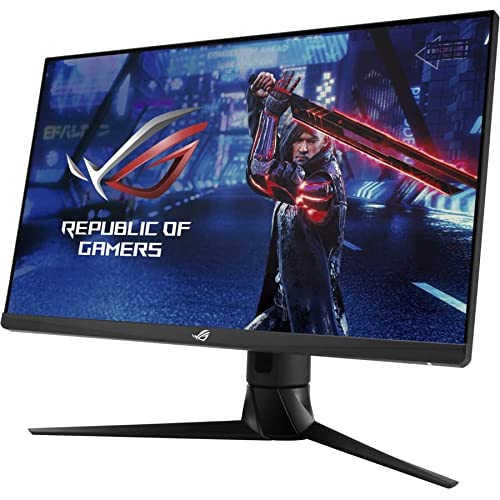
True Score
78772Experts
841kCustomers
Mixed Reviews
 $799.97
$799.97Snapshot
Reasons to Buy
- Low input lag, fast response time, and high refresh rate for gaming
- Gaming-oriented design and lighting
- High color accuracy
- Wide viewing angles
Reasons to Avoid
- Mediocre blacks
- Poor local dimming
Specifications
Display Type LCD HDMI Inputs 2 HDR Format HDR10 Max Resolution 2560 x 1440 
Panel Type Fast IPS Refresh Rate 270 Hz 
Response Time 0.5 ms Screen size 27″ 
Sync Technology Adaptive Sync All Specs
Test Results
Brightness (nits) 269 Contrast Ratio (as ratio, x:1) 1,121 Color Gamut/Accuracy % (DCI P3 xy) 93 Color Gamut/Accuracy % (DCI P3 uv) 0 Color Gamut % (Adobe RGB Coverage xy) 85 Color Gamut % (sRGB Coverage xy) 99 All Retailers
- $799.97
Our Verdict
For graphic designers who moonlight as gamers, the Asus XG27AQM blends professional-grade color accuracy and gaming prowess. With a snappy input lag of 8.4 ms and a swift response time of 5.1 ms, it ensures smooth and clear visuals during work and play, complemented by an impressive 270 Hz refresh rate for an ultra-smooth viewing experience.
The monitor excels in color fidelity with 99.10% sRGB and 93.3% DCI P3 coverage, making it ideal for a broad spectrum of design tasks from web and graphic design to video editing. However, its brightness level of 269.0 nits, while sufficient for most indoor settings, might not be optimal for workspaces bathed in strong natural light. This means the monitor’s average reflectivity of 5.1% is less of an issue since the low brightness makes it a bad choice for bright offices.
Despite its lower luminance, the XG27AQM incorporates eye-care technologies such as a blue light filter and a flicker-free display, prioritizing comfort during extended use. This makes it a versatile choice for designers and gamers who value visual precision and ergonomic design.
The Asus XG27AQM’s price tag is the biggest hurdle to clear, but it justifies its higher price point through fantastic gamut coverage, exceptional refresh rates, and responsive performance. If you need a one-size-fits-all solution for high-end gaming and professional design needs, the XG27AQM delivers on both fronts and can easily meet the light demands of other tasks like general productivity, spreadsheets, and web browsing.
Which Criteria Matters for Testing Best Monitors for Graphic Design?
By focusing on these criteria (2 required), anyone can quickly and easily compare these computer monitors and how they’ll perform. This helps you make an informed decision and purchase the best monitors for graphic design.
| CRITERIA | RANGE | REQUIRED | DEFINITION |
|---|---|---|---|
| Contrast Ratio | >1000:1 | Yes | The difference in brightness between the whites (lit sections) and blacks (dim or unlit sections) of a monitor panel. |
| Color Gamut (DCI P3 xy) | > 85% | Yes | How much of the DCI P3 xy color gamut is covered by the monitor, which helps indicate color accuracy for HDR content, which includes certain movies. |
Our Trusted Data Sources
We looked at 110+ computer monitor reviewers and found that 33 are trustworthy (60%+ Trust Rating). The three we have listed below are our most trusted for computer monitors.
- Samuel Breton – Rtings, MuckRack
- Chris Eberle – Tom’s Hardware, LinkedIn
- Tony Hoffman – PC Mag, MuckRack
Interested in a comprehensive analysis of our data sources? We’ve got you covered. Below, you’ll find a detailed list of every computer monitor review website we’ve identified, organized by their respective Trust Ratings from highest to lowest. But we didn’t stop there. We’ve meticulously reviewed each publication and verified the data by checking whether the authors have bio links to MuckRack or LinkedIn. We’re committed to not only checking the facts but ensuring their veracity.
Computer Monitor Test Data & Results
1. Contrast Ratio (as ratio, x:1) Test Results
Contrast Ratio
> 1000:1
Acceptable range of performance
Definition: How bright the monitor will get, usually under specific testing conditions, like 10% windows (which means 10% of the screen is a white box.)
Units of Measurement: Ratio
Tools to Measure: Luminance meter or photometer or colorimeter
Why It’s Important:
Contrast ratio is how dynamic images are given detail and dramatic effect, with very dark areas appearing truly dark, while bright areas are bright and pop.
Contrast ratio is responsible for making images appear “dynamic” and “dramatic.” By having a good contrast ratio, a monitor is able to recreate dramatic differences between light and dark spots in scenes, images and games accurately.
At a minimum, we recommend a contrast ratio of 1000:1, as this will do a good enough job at allow for detail in dark scenes and images. If contrast ratio gets too low, the picture quality suffers, and the monitor performs worse across the board, no matter the lighting condition. By getting a monitor with a sufficiently high contrast ratio, you can ensure the picture quality doesn’t suffer, and dramatic scenes with stark shifts in lighting, whether they be in games or videos, are created as accurately as possible.
Contrast Ratio (higher is better)
2. Color Gamut/Accuracy % (DCI P3 xy) Test Results
Color gamut is responsible for making a monitor produce accurate colors when displaying a variety of content. The DCI P3 xy gamut is considered a “standard” gamut of sorts, and is used to help color grade films. Most HDR content will use this gamut at the very least (though other gamut exist) and it’s a commonly used gamut for films.
When it comes to a computer monitor, having a panel that covers at least 85% of the DCI P3 gamut means it’ll output accurate colors when watching HDR content and movies that use the gamut. If a monitor doesn’t cover enough of the gamut, it causes color inaccuracies and shifts the image quality. If you care about maintaining accuracy in the movies you watch so they look the way they were intended, this gamut needs to be properly covered.
Color Gamut/Accuracy % (DCI P3 xy)
> 85%
Acceptable range of performance
Definition: The amount of the DCI P3 xy gamut that the monitor covers.
Units of Measurement: %
Tools to Measure: Colorimeter
Why It’s Important:
Color gamut coverage is important for ensuring that a monitor is able to accurately output colors. The DCI P3 xy gamut is responsible for making movies and HDR content look the way they were intended.
Color Gamut P3 XY (in %; higher is better)
Best Monitors for Graphic Design: Mistakes To Avoid
- Ignoring Color Accuracy: For graphic design, color accuracy is paramount. Avoid monitors that don’t offer high color accuracy or aren’t factory calibrated. Look for monitors with IPS or similar panels known for accurate color reproduction. Similarly, the best photo editing monitor will also prioritize accurate color representation, helping photographers to edit their images with precision and clarity.
- Not Considering Resolution: Higher resolution monitors offer more screen real estate, which is beneficial for graphic design work. Avoid lower resolution displays, as they may not provide the detail and clarity necessary for precise work. For designers seeking superior detail, 4K monitors deliver exceptional clarity, making intricate design work easier and ensuring that every fine line and color gradient is displayed with high precision.
- Neglecting Screen Size: While larger screens can be beneficial, they also require more desk space. Avoid getting a monitor that’s too large for your workspace or too small for comfortable viewing. An excellent 32″ monitor can strike a balance between providing ample screen space for productivity and still fitting comfortably in most setups.
- Overlooking Panel Type: Different panel types, such as IPS, TN, and VA, offer different advantages and disadvantages in terms of color accuracy, viewing angles, and response times. Avoid monitors with TN panels, as they generally have inferior color accuracy and viewing angles compared to IPS panels.
The Best Monitors for Graphic Design Tests Compared
Product |
True Score
|
Brightness
|
Contrast Ratio
|
Color Gamut (DCI P3)
|
Color Gamut (sRGB)
|
Input Lag
|
Response Time (ms)
|
Reflections %
| |
|---|---|---|---|---|---|---|---|---|---|
| 85 |
|
|
|
|
|
|
| $199.99 $300 $100 |
| 83 |
|
|
|
|
|
|
| $749.99 $1,000 $250 |
| 82 |
|
|
|
|
|
|
| $253.00 $300 $47 |
| 78 |
|
|
|
|
|
|
| $449.99 $650 $200 |
78 |
|
|
|
|
|
|
| $799.97 |

